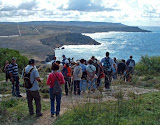From the Times of Malta - Friday, 30th October 2009
Cry, the beloved countryside*
The pathways at Ta' Baldu, which are government-owned have been landscaped with hard stone and access to them barred. Photo: Alex Vella/Malta Ramblers Association.
The onslaught on the countryside has continued unabated as the law is breached with impunity in various parts of the island, according to Lino Bugeja, president of the Ramblers Association of Malta.
Together with Mr Bugeja and another two members of the association, we had gone to Ta' Baldu on the way to Simblija near Dingli. These agricultural and historical gems are two of the highlights of one of the treks the ramblers organise annually.
Ta' Baldu contains various archaeological and rural remains. Beneath several farmhouses are a number of caves one of which incorporates a system of irrigation with water gushing from a spring. The date 1629 is inscribed on one of the walls.
Nearby, a string of rubble walls of excellent workmanship rise up to five metres.
A farmer who owns part of the land said that when she once asked her mother who had built these exceptional walls, the answer she got was: "They were built by the devil in three days".
At Ta' Baldu, several pathways that are government property - the area has been scheduled by the planning authority - have been landscaped with hard stone and several entrances barred by means of iron gates. Most of the caves also have had an iron gate fitted barring access to the public.
These actions have outraged Mr Bugeja and fellow ramblers.
"Every year we notice a worsening of the situation as more land is clutched away from the enjoyment of the Maltese," Mr Bugeja said.
Moving on to Simblija, one of the pathways is "guarded" by a pack of dogs that scare the daylights out of anyone who dares attempt go forward. Signs reading Keep Out in several languages often make visitors turn back. Rusted oil tanks "adorn" parts of the rubble walls.
Simblija is characterised by a mediaeval chapel and the remains of an agricultural village from the late mediaeval period.
The trek takes in Wied Liemu, lying between Dingli and Rabat. This valley is being spoilt by the building of rubble walls twice the height of the legal limit of four feet, Mr Bugeja notes.
This disfigurement is particularly evident on the Nigret side of the valley near a vineyard that is additionally scarred by mounds of rubble. These blots spoil the view of ramblers who meander along the winding walkways.
"Soon swathes of red clover will carpet the land but, if matters deteriorate further, one will only be able to enjoy this breathtaking view with the help of binoculars from Nigret Hill," Mr Bugeja lamented.
*With apologies to Alan Paton
















































